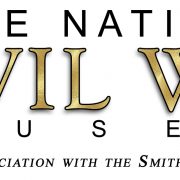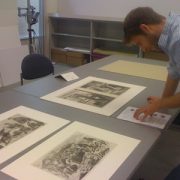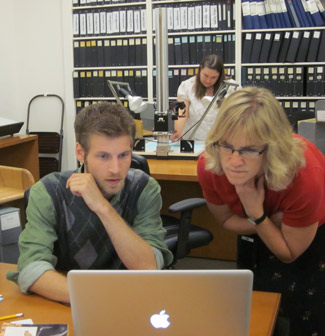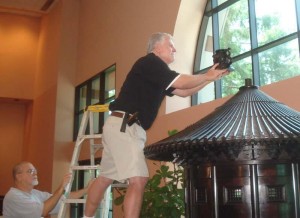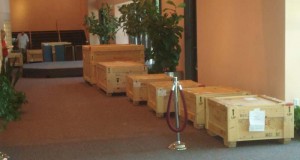We invited our recent Smithsonian Affiliate interns and visiting professionals to blog about their experiences in our Summer at the Smithsonian series. Below, Eric Stanley, curator of exhibitions and collections at Sonoma County Museum (Santa Rosa, CA), describes his spring residency at the Smithsonian. Special thanks to Eric Stanley for this post.

Eric meeting with Peter Liebhold and other curators at NMAH to discuss the "Bittersweet Harvest" exhibition
Seeking insights into the process of creating history exhibitions, I spent two weeks in March at the National Museum of American History (NMAH) through the Smithsonian Affiliations Visiting Professionals Program. While I was expecting exposure to a select few elements of the process, it was my great pleasure to be introduced to many facets of creating exhibitions, as well as some other management and collections issues at NMAH. During the course of my program, I met over thirty people at the Smithsonian, mainly at American History, and was able to learn something from each of them. The time I spent with those individuals, each one knowledgeable, enthusiastic, and warmly receptive of my presence, was a tremendous benefit to me and my institution.
Early in my program, I met with Paula Johnson, Curator in the Division of Work and Industry. Our conversation focused mainly on the exhibition On the Water. She shared with me the various stages of exhibition conception and design; fundraising; label writing; artifact selection; which elements were most successful and why; and many other topics. As the Sonoma County Museum moves into the process of creating larger, longer term exhibitions, the exposure to Paula’s approach was useful.

Eric meets with Peter Liebhold and Steve Velasquez at NMAH.
Two particular appointments helped me appreciate the craftsmanship, planning and effort involved in the physical production of exhibition cases, graphics and other components. I met with Omar Wynn, Director of the Office of Exhibits Production at NMAH and toured the museum’s production areas. I also had the opportunity to see Omar and his staff at work in the First Ladies’ gallery in preparation for receiving and installing Michelle Obama’s gown. His outlook on the relationship between his production staff and the curators, and his intense commitment to uphold his standards was thought provoking and inspiring. Similarly, I had the unusual opportunity to tour the Office of Exhibits Central and met with graphic designers, curators, collections managers, and production people associated with the facility.
One of the most relevant and insightful meetings I had was with Nigel Briggs, Exhibit Designer. The core goal of my program was to gain some knowledge of contemporary exhibition design standards and aesthetics, which is a challenging and complex question. History exhibitions throughout the country take a remarkably diverse approach, so defining one standard is nearly impossible. However, Nigel provided me some very practical insights and discussed the “look” of a number of exhibitions and what made them appear dated or contemporary. My only regret was not being able to spend a little more time in conversation with him.
Finally, I had an exceptionally productive meeting with the team who created the Bittersweet Harvest: The Bracero Program, 1942-1964 exhibition. Since the Sonoma County Museum is taking this SITES exhibition in November, it was an enormous benefit to be able to interact with the people who actually created the exhibition. I had a chance to discuss their approach to the collection and oral histories from former braceros; we are planning to employ a similar approach to collect bracero oral histories locally. We also recently were awarded a SITES grant to support our programming for Bittersweet Harvest.

Eric was presented with a certificate of award from Affiliations Director Harold Closter and NMAH Affiliations Program Manager Rosemary Phillips.
There were other, very productive meetings that I did not mention here. The broad overview that I was provided through my program was an undeniably valuable experience and afforded me an unusual, insider’s glimpse of one of the finest history museums around. I could not have been more pleased with the support and encouragement I received from Smithsonian Affiliations staff and from the Affiliations Program Managers at NMAH. My participation in the Visiting Professionals Program is an experience I will never forget.
Next in the series: Annette Shumway- Affiliations Intern Partner from the Frost Art Museum at Florida International University (Miami, FL).
 The Air Zoo (Portage, MI)
The Air Zoo (Portage, MI) National Museum of Nuclear Science & History (Albuquerque, NM)
National Museum of Nuclear Science & History (Albuquerque, NM) Frazier Museum of International History (Lexington, KY)
Frazier Museum of International History (Lexington, KY) Arizona Historical Society (Tucson, AZ)
Arizona Historical Society (Tucson, AZ) Snug Harbor Cultural Center (Staten Island, NY)
Snug Harbor Cultural Center (Staten Island, NY)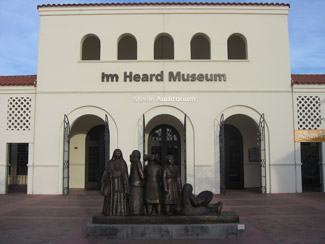 Heard Museum (Phoenix, AZ)
Heard Museum (Phoenix, AZ) Japanese American National Museum (Los Angeles, CA)
Japanese American National Museum (Los Angeles, CA)





